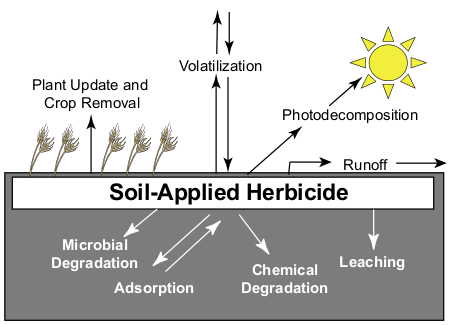Tools to Prevent and Diagnose Herbicide Injuries
Researchers and graduate students at Montana State University have been evaluating the potential damage that soil-applied herbicides can cause in crops. To maximize the benefits of these herbicides, while avoiding carryover and crop injury, we have assessed different crops and soil types across Montana.
This information has been compiled to provide agricultural professionals across the State of Montana the necessary tools to prevent and diagnose herbicide injuries.

Factors affecting the fate of soil-applied herbicides.
The content presented here includes:
- a 3-step key to assess herbicide injuries developed by the University of Wisconsin
- a Power Point presentation summarizing our research
- a series of high quality photos showing the responses of twelve crops to several soil applied herbicides
- a PDF document that provides an overview of the factors that influence the fate, effectiveness, and persistence of soil applied herbicides
Collectively, this information assists in the development of integrated weed management in agricultural fields. To minimize the risk of herbicide-injured crops, we need to understand how herbicides function, and the several factors that affect their activity.
3-step Key to Assess Herbicide Injuries
Designed to determine which herbicides may be responsible for injury, this key uses herbicide mode of action because herbicides with the same mode of action cause similar symptoms.
- Herbicide Mode of Action Key for Injury Symptoms (PDF)
- by Chris Boerboom, University of Wisconsin Extension
Herbicide Injury Symptoms
Soil-applied herbicides can be quite valuable in weed control, misuse can cause crop injury, or failure to control weeds. This guide is an overview of factors that influence the fate, effectiveness and persistence of soil-applied herbicides.
- Getting the Most from Soil-Applied Herbicides (PDF)
- MSU Extension MontGuide
Rethinking Montana Agriculture and Weed Management
In the Northern Great Plains there is growing interest in shifting from the traditional wheat-fallow system to a more diversified one. This shift in crops forces us to modify our approach to weed management.
- Reducing Crop Injury from Soil-Applied Herbicides (PDF available upon request)
- Powerpoint Presentation, Fabian Menalled, MSU Extension
Further Information
See the Weed Management section of the MSU Extension Cropweed Management resources page, or contact a cropweed specialist.

